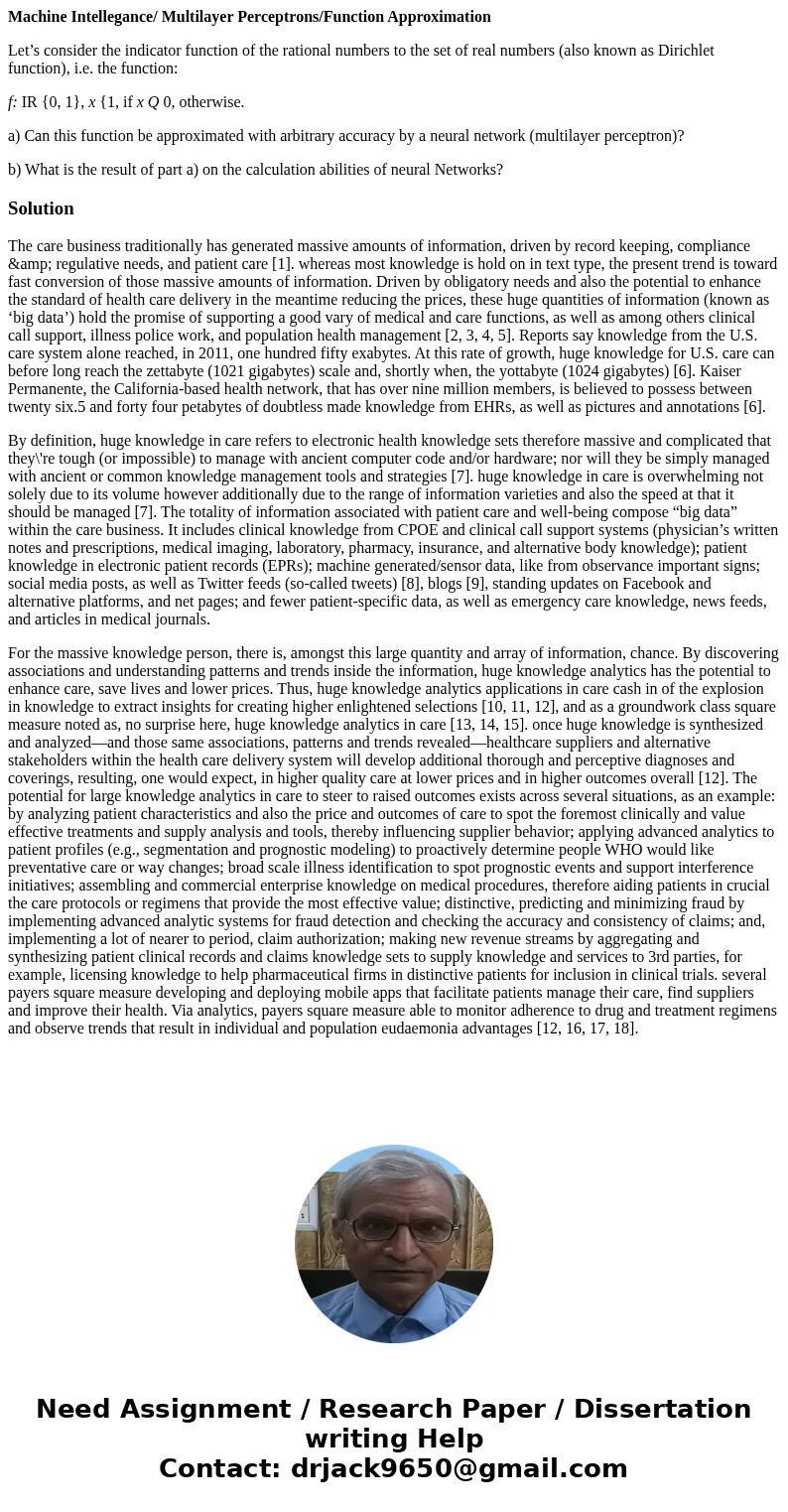Machine Intellegance Multilayer PerceptronsFunction Approxim
Machine Intellegance/ Multilayer Perceptrons/Function Approximation
Let’s consider the indicator function of the rational numbers to the set of real numbers (also known as Dirichlet function), i.e. the function:
f: IR {0, 1}, x {1, if x Q 0, otherwise.
a) Can this function be approximated with arbitrary accuracy by a neural network (multilayer perceptron)?
b) What is the result of part a) on the calculation abilities of neural Networks?
Solution
The care business traditionally has generated massive amounts of information, driven by record keeping, compliance & regulative needs, and patient care [1]. whereas most knowledge is hold on in text type, the present trend is toward fast conversion of those massive amounts of information. Driven by obligatory needs and also the potential to enhance the standard of health care delivery in the meantime reducing the prices, these huge quantities of information (known as ‘big data’) hold the promise of supporting a good vary of medical and care functions, as well as among others clinical call support, illness police work, and population health management [2, 3, 4, 5]. Reports say knowledge from the U.S. care system alone reached, in 2011, one hundred fifty exabytes. At this rate of growth, huge knowledge for U.S. care can before long reach the zettabyte (1021 gigabytes) scale and, shortly when, the yottabyte (1024 gigabytes) [6]. Kaiser Permanente, the California-based health network, that has over nine million members, is believed to possess between twenty six.5 and forty four petabytes of doubtless made knowledge from EHRs, as well as pictures and annotations [6].
By definition, huge knowledge in care refers to electronic health knowledge sets therefore massive and complicated that they\'re tough (or impossible) to manage with ancient computer code and/or hardware; nor will they be simply managed with ancient or common knowledge management tools and strategies [7]. huge knowledge in care is overwhelming not solely due to its volume however additionally due to the range of information varieties and also the speed at that it should be managed [7]. The totality of information associated with patient care and well-being compose “big data” within the care business. It includes clinical knowledge from CPOE and clinical call support systems (physician’s written notes and prescriptions, medical imaging, laboratory, pharmacy, insurance, and alternative body knowledge); patient knowledge in electronic patient records (EPRs); machine generated/sensor data, like from observance important signs; social media posts, as well as Twitter feeds (so-called tweets) [8], blogs [9], standing updates on Facebook and alternative platforms, and net pages; and fewer patient-specific data, as well as emergency care knowledge, news feeds, and articles in medical journals.
For the massive knowledge person, there is, amongst this large quantity and array of information, chance. By discovering associations and understanding patterns and trends inside the information, huge knowledge analytics has the potential to enhance care, save lives and lower prices. Thus, huge knowledge analytics applications in care cash in of the explosion in knowledge to extract insights for creating higher enlightened selections [10, 11, 12], and as a groundwork class square measure noted as, no surprise here, huge knowledge analytics in care [13, 14, 15]. once huge knowledge is synthesized and analyzed—and those same associations, patterns and trends revealed—healthcare suppliers and alternative stakeholders within the health care delivery system will develop additional thorough and perceptive diagnoses and coverings, resulting, one would expect, in higher quality care at lower prices and in higher outcomes overall [12]. The potential for large knowledge analytics in care to steer to raised outcomes exists across several situations, as an example: by analyzing patient characteristics and also the price and outcomes of care to spot the foremost clinically and value effective treatments and supply analysis and tools, thereby influencing supplier behavior; applying advanced analytics to patient profiles (e.g., segmentation and prognostic modeling) to proactively determine people WHO would like preventative care or way changes; broad scale illness identification to spot prognostic events and support interference initiatives; assembling and commercial enterprise knowledge on medical procedures, therefore aiding patients in crucial the care protocols or regimens that provide the most effective value; distinctive, predicting and minimizing fraud by implementing advanced analytic systems for fraud detection and checking the accuracy and consistency of claims; and, implementing a lot of nearer to period, claim authorization; making new revenue streams by aggregating and synthesizing patient clinical records and claims knowledge sets to supply knowledge and services to 3rd parties, for example, licensing knowledge to help pharmaceutical firms in distinctive patients for inclusion in clinical trials. several payers square measure developing and deploying mobile apps that facilitate patients manage their care, find suppliers and improve their health. Via analytics, payers square measure able to monitor adherence to drug and treatment regimens and observe trends that result in individual and population eudaemonia advantages [12, 16, 17, 18].

 Homework Sourse
Homework Sourse